Housing Cattle
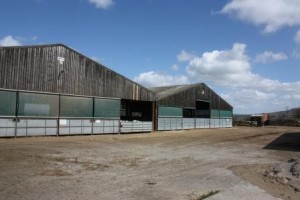 Whether cows are housed in cubicles, straw yards or cow sheds, in order to maximise performance and to ensure satisfactory standards of welfare, the accommodation must at least provide for the animal’s most basic needs.
Whether cows are housed in cubicles, straw yards or cow sheds, in order to maximise performance and to ensure satisfactory standards of welfare, the accommodation must at least provide for the animal’s most basic needs.
As an absolute minimum, the housing must provide a comfortable, clean, well-drained and dry lying area together with shelter from adverse weather, space to allow the animal to move, lie down and rise freely as well as access to adequate food and water. All housing for cattle should include an adequate provision of calving pens and sick pens for isolation of sick or injured animals. All cattle farms should also have provision for isolation and quarantine of bought-in animals in a separate building, unless the herd is genuinely closed and never buys in replacement or breeding animals.
If the housing system does not provide for these basic needs, then not only will both production and welfare be compromised, but it is likely that you are also failing to comply with the welfare codes and the law relating to animal welfare in your area.
Cubicles
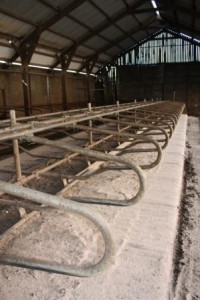 Cubicle management should be similarly well planned, as uncomfortable or unsuitable cubicles can lead to poor occupancy, wet and soiled cubicle beds, increased risk of udder disease and lameness as well as physical damage to the cows.
Cubicle management should be similarly well planned, as uncomfortable or unsuitable cubicles can lead to poor occupancy, wet and soiled cubicle beds, increased risk of udder disease and lameness as well as physical damage to the cows.
Appropriate cubicle length will accommodate the need for both forward lunging space and rear clearance to ensure the animal doesn’t soil the bedding. Equally important, the cubicle should be wide enough for the cow to lie down without rubbing against the partitions, but narrow enough to prevent them turning around. The required dimensions of a cubicle are dependent on the size of the cow, however DairyCo have created a useful guide to calculating the right sized cubicle for your system.
To compliment a good cubicle set up, a suitable depth and choice of bedding will ensure comfort when lying down as well as preventing knee and hock injuries. When choosing bedding, consider:
- Thermal insulation properties
- Softness
- Traction
- The use of lime under fresh bedding, not on top of it
- Low risk of abrasion
- Easily maintained
- Cost effective
Cubicle bases other than concrete should also be considered. Sand (must be washed) and limestone, in particular, have advantages over concrete-based beds with regard to cow comfort, but require careful maintenance.
Loose Housing
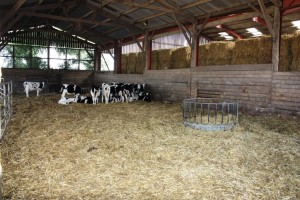 Whilst it is well recognised that lameness, fertility and general injuries to cattle are less severe in straw yards, mastitis tends to be a greater problem than in cubicle-housed cows. If the straw yard system is chosen, best possible straw yard management should be implemented, with frequent clearing of yards (maximum 5 weeks) and plentiful bedding, with dry straw, both mornings and evenings.
Whilst it is well recognised that lameness, fertility and general injuries to cattle are less severe in straw yards, mastitis tends to be a greater problem than in cubicle-housed cows. If the straw yard system is chosen, best possible straw yard management should be implemented, with frequent clearing of yards (maximum 5 weeks) and plentiful bedding, with dry straw, both mornings and evenings.
Appropriate design of yards, avoiding dampness and contamination from water troughs and narrow entry points, is equally important. Separate housing of first calving heifers should be considered (see also Herd Health for more on disease risks associated with housing)
| Breeding and fattening cattle. (Live weight kg) | Lying area (metres squared per head) | Additional area (metres squared per head) | Total available area (metres squared per head) |
| Up to 100 | 1.5 | 1.1 | 2.6 |
| Up to 200 | 2.5 | 1.9 | 4.4 |
| Up to 350 | 4.0 | 3 | 7 |
| Above 350 | 1m2 per 100kg (with a minimum of 5m2) | 0.75m2 per 100kg(with a minimum of 3.7m2) | 1.75m2 per 100kg(with a minimum of 8.7m2) |
| Dairy cows | 6 | 4.5 | 10.5 |
The lying area must be under cover and bedded. The additional area may be inside or outside and does not have to be bedded.
Loafing Areas
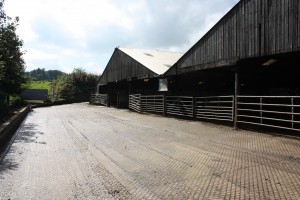 A loafing area is a space cows can use for behaviours other than feeding or lying- such as displaying oestrus behaviour and social bonding. Cattle can spend a lot of time utilising outdoor loafing areas, often using the area to regulate body temperature when humidity and temperature are high.
A loafing area is a space cows can use for behaviours other than feeding or lying- such as displaying oestrus behaviour and social bonding. Cattle can spend a lot of time utilising outdoor loafing areas, often using the area to regulate body temperature when humidity and temperature are high.
It is advised that the loafing area size is 120% of the cubicle lying area. Loafing areas can include non-feed passageways and non-lying areas. Although loafing is provided at pasture, the weather limits utilisation of such areas and thus an indoor loafing area with access to an outdoor loafing area is desirable.
As with housing, the amount of slurry in the loafing areas should be managed, and scraped at least twice daily to prevent health problems and encourage use.
Surfaces and Flooring
The lying surface of a housing system can influence udder health. The rate of new mastitis infection increases with the number of bacteria at the teat end. Cleaner environments have a direct association with cleaner cows, which in turn result in healthier, more profitable animals. There are many surface options to choose from, but the following properties should be considered when choosing a surface:
The floor surface must also be easy to keep clean whichever cleaning system you use. Keeping the environment clean, and free from slurry is a continual battle, however, there are several ways to help with this daily task, each of which have advantages and disadvantages. The table below summarises some options.
| System | Pro’s | Con’s |
| Tractor Mounted Scraper |
|
|
| Automatic Scrapers |
|
|
| Flush Wash |
|
|
Cow Comfort
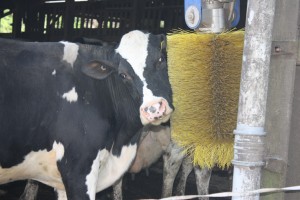 A comfortable cow is a happy cow, and a happy healthy cow in turn, proves to be a profitable cow. Grooming aids are a great addition to any farm, and are often used extensively by cattle once installed. Grooming is a natural social activity for cows, and brushes have proven to positively contribute to the welfare of housed animals.
A comfortable cow is a happy cow, and a happy healthy cow in turn, proves to be a profitable cow. Grooming aids are a great addition to any farm, and are often used extensively by cattle once installed. Grooming is a natural social activity for cows, and brushes have proven to positively contribute to the welfare of housed animals.
Ventilation
When designing new buildings, ventilation should be carefully considered as poor ventilation can cause health and welfare issues. Air circulation, dust levels, temperature and relative humidity must be kept within limits that are safe for both animals and humans. Desirable ventilation properties include the ability for the building to remove excess heat, water vapour, dust and microorganisms as well as being able to provide a uniform distribution of air and provide the correct air speed for stock.
DairyCo’s publication on Dairy Housing, a best practice guide has a guide on useful guide on ventilation, including how to work out ventilation calculations appropriate to your system.
Good Practice
- A lot of care should be taken with straw yard and cubicle management.
- Straw yards should be cleared at the maximum interval of five weeks and only dry straw should be used.
- Cubicles should be renewed if they do not meet the minimum size standards or are in poor repair or otherwise unsuitable for the type of cow in the herd.
- The number of cubicles should always exceed the number of cows in each housing area and group by a minimum of 5%
- Cleaning of the walkways should be carried out at least twice a day. If automatic scrapers are used, cattle should be moved to bedded areas or cubicles while the scrapers operate.
- Cattle cleanliness should be continuously monitored during the housing period: if cattle are dirty, management routines and bedding have to be improved.
- Feet problems should also be monitored carefully during the housing period, and immediate improvements in cleaning, drainage and bedding should be implemented if deterioration in foot health is observed – particularly since routine use of topical antibiotics or antibiotic footbaths is not acceptable.
- Separate housing of first calving heifers on straw yards should be considered.
- Dry cow housing should be carefully designed and managed, with the same space allowance as for milking cows.
- If lice are a problem in housed beef cattle, special care should be taken in cleaning and disinfecting the housing during the grazing period
- Animal welfare indices developed for the assessment of the animal’s environment should be utilised in measuring housing quality and in identifying shortcomings and animal-based welfare assessment should be used to evaluate the effectiveness of housing with regards to key welfare issues such as injuries.


 American English
American English

Comments are closed.